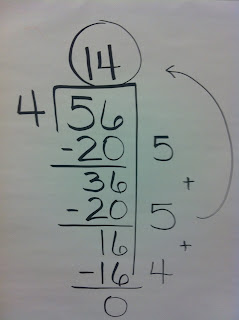Consider 56 divided by 4
When looking at this division problem, we ask ourselves, “How many 4’s are in 56?”. By doing this, we recognize that we will be finding the number of groups of 4 that are in 56, or _____ x 4 = 56.

Other students would incorporate this same strategy into a different model, such as a Multiplication Cluster. The approach uses decomposition of one of the factors to make smaller, easier probloems. In the example below, again 14 is decomposed into 10 and 4 to make the two easier problems. 10 groups of 4 is 40. Adding another 4 groups of 4 (4x4) or 16 “builds” 14 x 4 = 56. 
A more advanced strategy would be to take the dividend (total) and decompose it into smaller multiples of the divisor to make smaller division problems that would “build “ (add up to) the original division problem. This method is called a Division Cluster. 56 could be decomposed into 20 + 20 + 16 and solved as three smaller division problems. 20 divided by 4 is 5. 20 divided by 4 is 5. 16 divided by 4 is 4. 56 divided by 4 is 14.
Last but not least, the Partial Quotients Method (also lovingly referred to as the “Russian Peasant” Method), is a special model we move our students toward in order to progress their thinking into a more “standard algorithmic” set-up. If you look carefully at the smaller problems that are solved in each of the examples shown below, you will see that they are the same as in the earlier examples. Even though the mathematical “models” are different, the “strategy” of using good mathematical sense to decompose the dividend into smaller numbers (landmark multiples of ten or single digit numbers) is the same, so that the reasonableness of solutions can be easily assessed (Does my answer make sense?).

Promoting this deep understanding at Grade 4 will then more easily transfer later (5th Grade) into understanding why the division algorithm works (which is very abstract in nature and cumbersome to understand conceptually).
Happy Dividing!
P.S.- Students, leave a comment sharing your favorite divison strategy (and why), and earn Behavior Bucks to spend at your next class auction!



My favorite division strategy is partial quotient or Russian peasant. And my favorite multiplication strategy is multiplication cluster. Math is my favorite subject!!! Carter
ReplyDeleteI like the Russian Peasant method because it's mental math with subtraction.
ReplyDeleteDavis G.
GO DIVISION! GO MATH! GO SCHOOL!.....and GO....... SUPERHEROS!
ReplyDeleteISIS
Um... I don't know if I have a favorite math strategy for division. I quess it's thinking really hard. Though, my favorite subject is science!!! Mattie
ReplyDeletei love math
ReplyDeleteSa Tasha T.
I like the Russian Peasant and the Fish Bone because you can have a clear and easy way to do division problems with large numbers or small numbers. Love, Chelsea B.
ReplyDeletemy favirote strategy is russian preasnt alexis b
ReplyDeleteMy favorite math strategy is the Fish Bone!
ReplyDeleteBecause to me it is a really efficient strategy
Tara R.